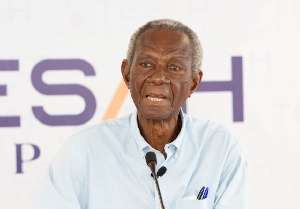More than a year and a half after the Bank of Ghana announced the completion of its banking industry reforms and a year after it finished extending those reforms to savings and loans firms, micro-financiers and other specialized deposit taking institutions, controversies still linger over what the central bank did and how it went about it.
To be sure, this was always inevitable considering the sheer weight of the vested interests that were so adversely affected. Add the inevitable political machinations in the run up to crucial general elections and it makes for a volatile mix that could fuel the controversy for quite some time to come.
However, recent events and trends have come to the defence of the reformists at the BoG.
The clearest one is the way Ghana’s banking industry has smoothly navigated the unprecedented negative impacts of the biggest global medical pandemic in the history of the world.
Ghana’s banks have uniformly rode a panic-driven run on deposits, ahead of an outright lockdown of the country’s two biggest economic centres for three weeks ; extended restrictions on economic and social activities over several months; and ultimately a sharp slow down in economic activity accompanied by an enforced significant narrowing of bank interest margins on loans, following an agreement between government and the Ghana Association of Bankers to reduce interest rates on all ongoing and new loans by 200 basis points (two percent).
At the same time, their unprecedented financial solidity brought about by recapitalization above the new minimum core capital of GHc400 million has funded massive upgrades in digital banking capacities, which have proved crucial during the extended period of restrictions on physical movement and interactions.
But the fortunes of non-bank financial intermediaries – savings and loans companies, microfinanciers and other specialized non bank finance houses inclusive – have been even more instructive.
None of them have descended into insolvency and failed to honour withdrawal requests from customers since the socio-economic crisis caused by the COVID-19 outbreak began in March, although rumours of their increasing financial difficulties have begun making the rounds in recent weeks.
All this evidences the financial solidity achieved by financial intermediaries under the regulatory purview of the Bank of Ghana, through the recent industry reforms.
Simply put a pre-reform industry that was tottering on the brink of systemic insolvency even within a normal, relatively stable economic operating environment – with about half of the participants struggling to honour their obligations to their customers (many of them unsuccessfully) – has been transformed into a post-reform industry which has remained basically unscathed by the biggest economic crisis it has ever had to contend with.
All but the BoG’s most ardent critics readily agree that the pre-reform financial intermediation industry would have sunk under the weight of the financial challenges that COVID-19 has brought with it.
However, even erstwhile critics of the recent reforms who now admit to their crucial and timely impact, still argue that the cost of implementing them have been inimical to the state of Ghana’s public purse. To be sure the reforms have proved expensive, costing government some GHc14 billion in all so far, with further yet unpaid commitments of a further GHc5 billion or so.
Meanwhile, only about GHc1 billion has been recovered so far. This has had a dire effect on Ghana’s public indebtedness – without the cost of reforms, the country’s public debt would have been equivalent to about 54% of its Gross Domestic Product, rather than the 59.3% it stood at by the end of March this year.
But the critics have failed to calculate – or at least estimate – the cost of not implementing the reforms. Prior to the central bank’s drastic regulatory actions it had been providing unsecured Emergency Liquidity Assistance to troubled banks. But such support had not resolved the insolvency challenges of any of them – rather it had effectively amounted to throwing good money after bad money.
Conversely, while the cost of reforms through the issuance of resolution bonds to bridge the capital shortfalls of troubled banks while they were being consolidated or acquired, has been high, it has brought closure to the underlying problem – unsecured ELA is no longer required by undercapitalized banks or other genres of financial intermediaries.
Even more importantly, the banking public has largely regained its confidence in the financial intermediation industry as safe havens for their savings and investments.
In 2019, the first full year after the completion of reforms in the universal banking sector, customer deposits increased by some 18%, well above the 12% growth at the peak of the industry’s insolvency crisis.
Deposit growth has continued during the first half of 2020, despite the temporary blimp created by panic withdrawals between late March and mid-April when restrictions on socio-economic activities reached their peak.
Indeed, the panache with which even non-bank financial institutions met the dramatically sharp spike in customer deposit withdrawal requests immediately prior to the three weeks lock down in April has almost completely restored full customer confidence in a way even the most concerted publicity campaigns by the BoG could not.
Here again, the arrival of COVID -19 has inadvertently proved their worth of the recent industry reforms; the financial institutions left standing are solid enough to withstand severe stress, showing that deposits held with them are safe, at least for now.
Expectedly the array of corporate governance and risk management directives introduced by the central bank over the past two years should keep them that way.
But even the costs incurred may not be nearly as high as the BoG’s critics are claiming. To be sure, recoveries of assets from liquidated financial institutions are proceeding much more slowly than originally anticipated, in part because of the slowness of the requisite legal proceedings underpinning the recoveries.
But the latest agreement by William Ato Essien, kingpin at the liquidated Capital Bank, to refund GHc25 million in ill-gotten money diverted illegally from the erstwhile bank’s coffers opens a new frontier in government’s efforts to recoup monies it borrowed to resolve the capital shortfalls of the liquidated banks.
While some public policy commentators insist that prosecution and punishment of offenders such as Ato Essien should be the priority, government is simply being pragmatic in agreeing to cut deals that will allow such offenders refund illegally obtained monies in exchange for their continued freedom.
The logic here is that if you cannot have it both ways, take the one which is most practically useful to you.
Similar deals, entered into with more former bank chieftains facing prosecution have the potential to significantly increase financial recoveries and thus commensurately reduce the cost of the reforms to the public purse.
Unfortunately, however, most of the issues underlying the reforms, being highly technical, have been lost on, or completely misunderstood, by the general public. As industry regulator, the BoG has steadfastly gone ahead with its job, even as it has been deliberately cast as the villain of the piece by vested interests who are losing out.
Ultimately therefore, financial literacy is the best guard against improper conduct by Ghana’s financial intermediaries and failure to do this opens the door to the politicization of the reforms with inevitably grave consequences sooner or later.
Business News of Thursday, 24 September 2020
Source: goldstreetbusiness.com













